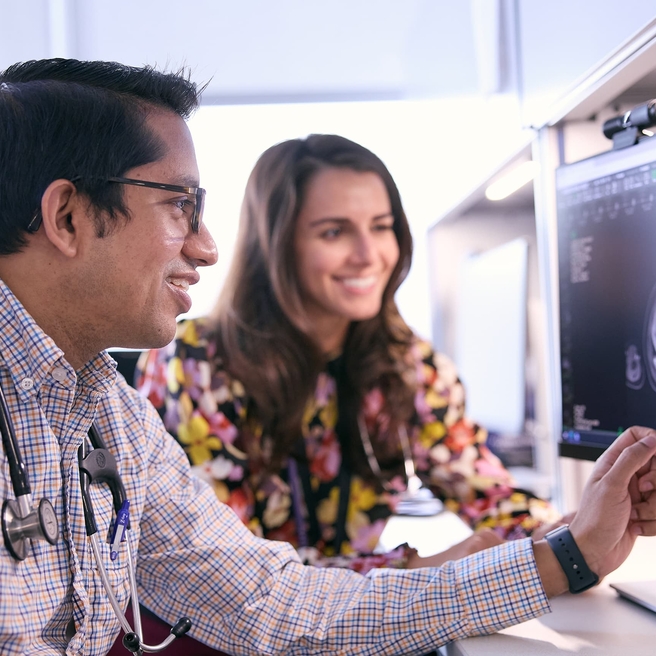What is VEO-IBD?
Very early onset-inflammatory bowel disease (VEO-IBD) is inflammatory bowel disease (IBD) that affects infants and children younger than 6 years old. It can cause chronic and recurrent inflammation in any part of the gastrointestinal (GI) tract from the mouth to the anus, and affects a child’s ability to grow, develop and meet developmental milestones.
IBD is an umbrella term for three conditions: Crohn’s disease, ulcerative colitis and indeterminate colitis (which has features of both ulcerative colitis and Crohn’s). Most children with IBD do not exhibit symptoms when they are very young; it tends to be diagnosed in early adolescence, between the ages of 8 and 15.
Children with VEO-IBD are often not classified as having either ulcerative colitis or Crohn’s disease in the early stages of their illness because the disease can change and adapt, presenting differently over the first few months or years of the disease. In some children, the diagnosis remains “indeterminate” even as the child grows older.
Like IBD, VEO-IBD can include periods of inflammatory symptoms (sometimes called “flare-ups”) and periods with no symptoms (remission).
Children diagnosed with VEO-IBD – a small, yet distinct subset of patients that make up about 15% of all pediatric IBD patients – can have a more complex disease and some children do not respond to traditional IBD treatments. Because of the differences in the disease course, children with VEO-IBD require individualized evaluation and targeted therapies.
Incidence of VEO-IBD has increased dramatically increased over the past 30 years – not only in the U.S. but worldwide. Recent studies have shown an increase in VEO-IBD of 7.2% per year, and at Children’s Hospital of Philadelphia (CHOP), we have seen a rapid rise in incidence as well.
Causes of VEO-IBD
The cause of VEO-IBD is different for every child and many times – similar to older children and adults with IBD – the cause is unknown. A combination of factors is known to cause VEO-IBD, including genetics, the immune system and the environment. The environment may include food, water, antibiotics, viruses, bacteria and all the organisms that live in the human gut.
In very rare instances, VEO-IBD can be traced to a mutation in a single gene or an immune defect. While this is not common, when discovered it can help the medical team determine the best treatment to address that specific defect. Very often, we do not discover one cause for VEO-IBD; but rather many potential causes.
Symptoms of VEO-IBD
While the clinical symptoms of VEO-IBD can vary from child to child, some symptoms are more common than others. Symptoms related to inflammation in the GI tract include:
- abdominal pain and cramping
- diarrhea
- blood in the stool
- weight loss
- fecal accidents or urgency to move bowels
- reduced appetite
- poor growth
Other symptoms may include:
- fatigue
- poor growth
- joint pain
- fevers
Symptoms of VEO-IBD can overlap with immune deficiencies and other rare diseases. Symptoms can also be confused with more common childhood ailments like acid reflux, toddler diarrhea or food allergies.
Diagnosing VEO-IBD
At Children’s Hospital of Philadelphia, the VEO-IBD team includes gastroenterologists, immunologists, registered dietitians, registered nurses, behavioral psychologists, social workers, and child life specialists.
To diagnose VEO-IBD, our gastroenterologists perform a thorough medical history, physical examination and a variety of tests to determine if a child has VEO-IBD, as well as tests to attempt to identify potential treatment options. Nurses, social workers and child life specialists work with families to calm and distract children and anxious families.
Testing for VEO-IBD may include:
- lab tests such as blood work and stool samples
- imaging studies
- endoscopy and/or colonoscopy with biopsies (a small piece of tissue sent to the lab to evaluate for inflammation or damage)
- genetic tests, such as CHOP’s VEO-IBD genetic panel that includes 98 known causative genes for this disorder.
These tests help to identify laboratory abnormalities, including anemia or low blood protein levels, identify areas of the digestive tract with active inflammation, and determine if there is a contributing infection. These studies will also look at different parts of the immune system to identify chances that may be contributing to the disease.
Imaging studies, such as magnetic resonance enterography (MRE), CT enterography (CTE), and ultrasound – as well as video capsule endoscopy – provide a detailed picture of the small intestine.
These, along with an endoscopy and colonoscopy, offer a head-to-toe look at the inside of the body. Our child life specialists provide age-specific educational resources to assist in coping and psychosocial support with procedures.
Preparing for Your Child's Appointment
Learn about what to expect when you visit the Very Early Onset Inflammatory Bowel Disease (VEO-IBD) Program at Children’s Hospital of Philadelphia (CHOP).
Treatment for VEO-IBD
Each child’s treatment plan for VEO-IBD is specialized and unique. Some children don’t respond to conventional IBD therapies or surgical interventions. Therefore, treatment for VEO-IBD often includes therapies that are specific for the individual child’s disease. In addition, nutritional therapy is an important part of the treatment plan.
Medication, routine lab work and regular medical appointments can help stop symptoms, prevent flare-ups and heal the GI tract.
For most patients, there is no cure for VEO-IBD. However, with treatment, VEO-IBD can be managed well; and not interfere in a child’s development, school activities or social interactions.
There are no limits to what children with VEO-IBD can do or become.
Reviewed by: Judith R. Kelsen, MD, and Andrew B. Grossman, MD
Resources to help
Very Early Onset Inflammatory Bowel Disease (VEO-IBD) Program Resources
We have created resources to help you find answers to your questions about IBD in very young children and feel confident with the care you are providing your child.
